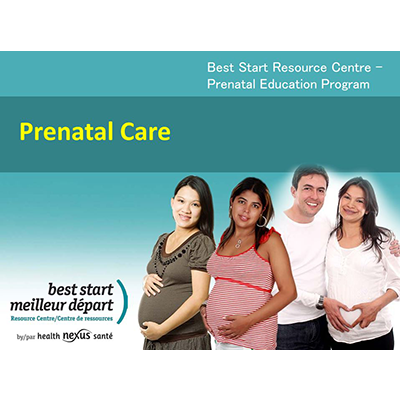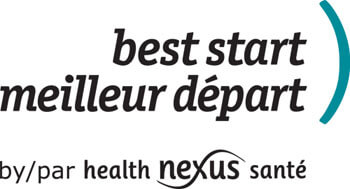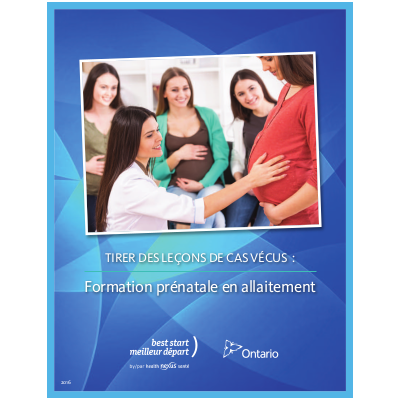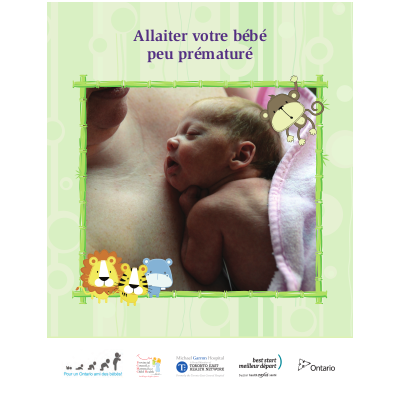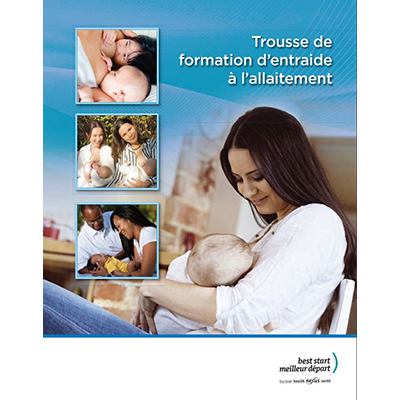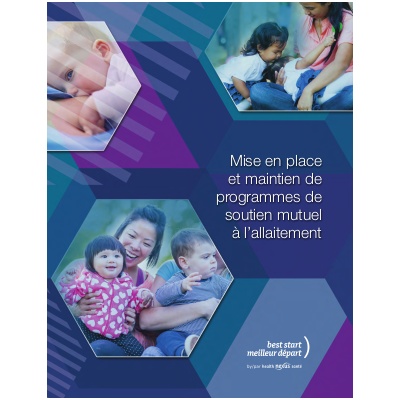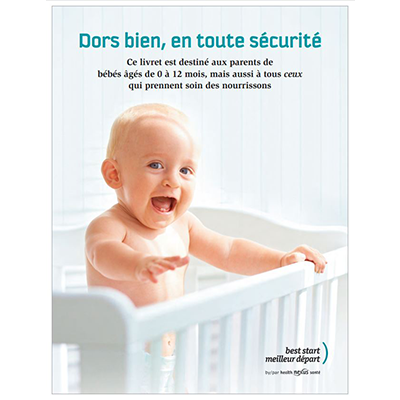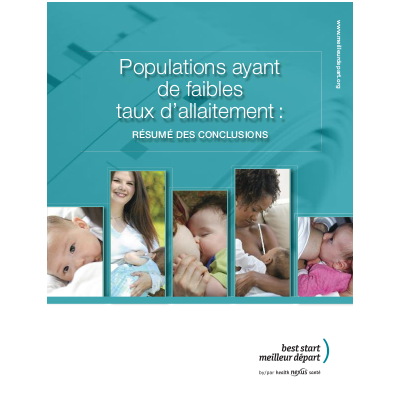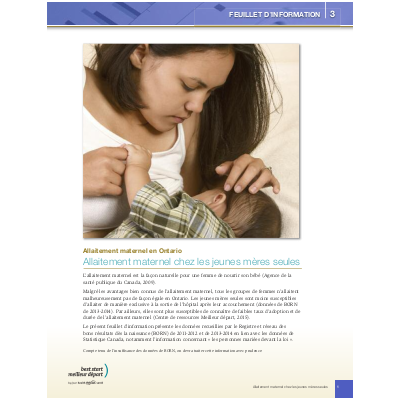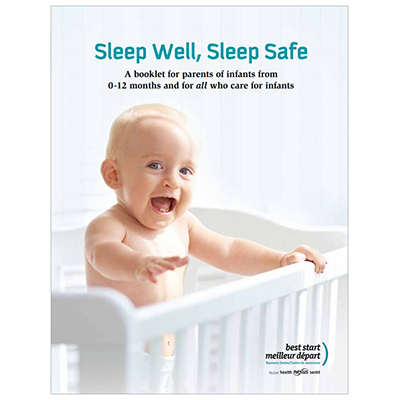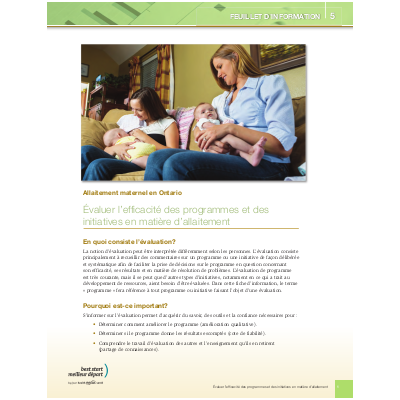The Prenatal Education Program is a teaching aid for face-to-face prenatal education sessions. The program consists of a series of 11 independent modules which are created in PowerPoint and available in PDF format from the webpage accessible by clicking above. Each module includes three files in PDF format: the slides in full size, the extensive speaker notes and a module outline (objectives, teaching aids, references, etc.). The content covers the stages of pregnancy and the transition to parenting. The audience for these modules includes the pregnant woman and her partner.
Module topics are 1. Prenatal Care, 2. Changes in Pregnancy, 3. Healthy Eating, 4. Physical & Emotional Fitness, 5. Environmental Exposures, 6. Labour and Birth, 7. Comfort Measures, 8. Medical Interventions & Caesarean Birth, 9. Breastfeeding Basics, 10. Postpartum Changes, and 11. Newborn Care & Safety.
Also available in French.
This booklet is part of a series of five Learning from Stories booklets, in which the actions being taken in Ontario to support breastfeeding were surveyed using a Healthy Communities Approach, and the qualitative results of the interviews gathered into stories by the interviewers/writers, in the hope of inspiring and helping service providers in Ontario to protect, promote, and support breastfeeding.
Literature and Ontario-based birth data show that breastfeeding rates, and in particular exclusive breastfeeding rates, are linked to prenatal education. Prenatal breastfeeding education can be provided in many formats. It is often led by a professional facilitator, but can also be led by another mother (peer). This booklet gives examples of peer-facilitated prenatal breastfeeding education in part one, and professional-facilitated prenatal breastfeeding education in part two.
Also available in English.
See also the other booklets of the Learning from Stories series:
Supporting Exclusive Breastfeeding (in English and French)
Breastfeeding Promotion to Increase Awareness and Confidence (in English and French)
Breastfeeding Education for Health Care Providers (in English and French)
Breastfeeding and Younger Women (in English and French)
Developed by the BFI Strategy for Ontario, the Breastfeeding Your Late Preterm Baby booklet supports families who have a late preterm baby born between 34 and 37 weeks gestation and who plan to breastfeed and/or provide breast milk to their baby. Topics include: breastfeeding your late preterm baby, skin-to-skin contact and Kangaroo care, tips to getting off to a good start, pumping, feeding your baby at the hospital and tips for when you take your baby home.
Also available in English, Arabic, Bengali, Chinese, Farsi, Gujarati, Hindi, Korean, Punjabi, Russian, Serbian, Somali, Spanish, Tagalog, Tamil, Urdu and Vietnamese.
The Breastfeeding Peer Support Training Toolkit will provide all you need to educate breastfeeding peer support volunteers, equipping them to begin supporting other breastfeeding mothers (peers).
In the toolkit you will find:
1. Introduction for the facilitator with information about recruiting and training potential peer support volunteers.
2. Six modules with facilitator notes. Each 2.5-hour module contains several activities.
3. PowerPoint presentations for each of the six modules in PDF format.
4. Peer Resource Guide with suggestions about additional handouts, and space where you can add information about your program, local programs and resources.
5. Training Summary Charts for each module which provide an outline of the content, timing, and materials needed for each module, including a training summary chart for a pre-training meet-and-greet.
Also available in English.
Available in low resolution, PDF format. For other formats and further information, please contact us.
This manual for service providers provides information about different types of breastfeeding peer-support programs. The description of different aspects of peer support, from assessing the community to ongoing support of the peer volunteers, will assist organization in planning the development of an effective program or support organizations in ensuring their program sustainability.
Also available in English.
The Sleep Well, Sleep Safe booklet is intended for parents of infants from 0-12 months and for all who care for infants.
This booklet is divided in three sections:
- Healthy Sleep Tips for Infants and for Parents : Be informed about recommendations on healthy sleep practices for parents and infants.
- Safe Sleep Tips for Infants 0-12 Months: Be informed on how to reduce the risks of Sudden Infant Death Syndrome (SIDS) and other sleep related causes of infant death.
- Frequently Asked Questions (FAQs) & answers and recommended resources: provide you with further information on healthy and safe sleep for infants.
Also available in English.
See also the following fact sheets, in English and French:
- The safest place for an infant to sleep : Did you know that the safest place for an infant to sleep is in a crib, cradle or bassinet?
- Attachment and sleep : Did you know that your infant needs your loving care to better develop healthy sleep habits? .
- Establishing routines : Did you know that routines are important to help infants sleep well?
- Creating safe sleep environments : Did you know that creating safe sleep environments will reduce the risks of infant death?
- Breastfeeding and Sudden Infant Death Syndrome : Did you know that breastfeeding reduces the risks of SIDS?
- Alcohol/drug misuse and Sudden Infant Death Syndrome : Did you know that avoiding alcohol and drug misuse can reduce the risk of infant death?
- Smoking and Sudden Infant Death Syndrome : Did you know that preventing exposure to tobacco smoke, during pregnancy or after pregnancy, reduces the risk of SIDS?
Although breastfeeding initiation in Ontario is 91.8%, there are populations with lower rates of breastfeeding.
The Best Start Resource Centre has completed four research validation strategies to confirm populations with lower rates of breastfeeding in Ontario as well as breastfeeding strategies that are effective with these populations. The resulting report highlights information about trends in Ontario, barriers, effective and promising strategies, and recommendations to reach populations with lower rates of breastfeeding.
Also available in English.
Part of a series of 5 fact sheets for service providers, exploring issues related to breastfeeding including trends in Ontario, this particular fact sheet focuses on strategies to address lower rates of breastfeeding among young single mothers in the province.
Also available in English
See also :
Fact Sheet 1: Notable Trends within the Province (in English and French)
Fact Sheet 2: Breastfeeding and Socioeconomic Status (in English and French)
Fact Sheet 4: Breastfeeding Peer Support (in English and French)
Fact Sheet 5: Evaluating Breastfeeding Programs and Initiatives (in English and French)
The Sleep Well, Sleep Safe booklet is intended for parents of infants from 0-12 months and for all who care for infants.
This booklet is divided in three sections:
- Healthy Sleep Tips for Infants and for Parents : Be informed about recommendations on healthy sleep practices for parents and infants.
- Safe Sleep Tips for Infants 0-12 Months: Be informed on how to reduce the risks of Sudden Infant Death Syndrome (SIDS) and other sleep related causes of infant death.
- Frequently Asked Questions (FAQs) & answers and recommended resources: provide you with further information on healthy and safe sleep for infants.
Also available in French.
See also the following fact sheets, in English and in French:
- The safest place for an infant to sleep : Did you know that the safest place for an infant to sleep is in a crib, cradle or bassinet? in English and French.
- Attachment and sleep : Did you know that your infant needs your loving care to better develop healthy sleep habits? in English and French.
- Establishing routines : Did you know that routines are important to help infants sleep well? in English and French.
- Creating safe sleep environments: Did you know that creating safe sleep environments will reduce the risks of infant death? in English and French.
- Breastfeeding and Sudden Infant Death Syndrome: Did you know that breastfeeding reduces the risks of SIDS? in English and French.
- Alcohol/drug misuse and Sudden Infant Death Syndrome: Did you know that avoiding alcohol and drug misuse can reduce the risk of infant death? in English and French.
- Smoking and Sudden Infant Death Syndrome: Did you know that preventing exposure to tobacco smoke, during pregnancy or after pregnancy, reduces the risk of SIDS? in English and French.
Part of a series of 5 fact sheets for service providers exploring issues related to breastfeeding including trends in Ontario, this particular fact sheet focuses on how breastfeeding programs and initiatives can be evaluated.
Also available in English.
See also:
Fact Sheet 1: Notable Trends within the Province (in English and French)
Fact Sheet 2: Breastfeeding and Socioeconomic Status (in English and French)
Fact Sheet 3: Breastfeeding among Young Single Mothers (in English and French)
Fact Sheet 4: Breastfeeding Peer Support (in English and French)
A collection of evaluation forms that have been used in various breastfeeding programs and initiatives across Ontario is also available.
